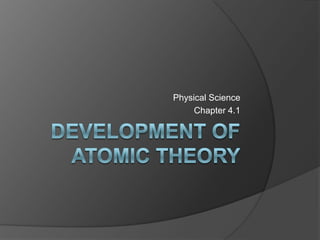Physical science 4.1 : Development of Atomic Theory
•Als PPTX, PDF herunterladen•
7 gefällt mir•4,346 views
Melden
Teilen
Melden
Teilen

Empfohlen
Empfohlen
Weitere ähnliche Inhalte
Was ist angesagt?
Was ist angesagt? (20)
Formation of Elements in the Big Bang and Stellar Evolution

Formation of Elements in the Big Bang and Stellar Evolution
Physical Science - Quarter 1 - Week 1 Discussion.ppt

Physical Science - Quarter 1 - Week 1 Discussion.ppt
Lesson 2 We Are All Made of Star Stuff (Formation of the Heavy Elements)

Lesson 2 We Are All Made of Star Stuff (Formation of the Heavy Elements)
Ähnlich wie Physical science 4.1 : Development of Atomic Theory
Ähnlich wie Physical science 4.1 : Development of Atomic Theory (20)
Mehr von Chris Foltz
Mehr von Chris Foltz (20)
Kürzlich hochgeladen
https://app.box.com/s/7hlvjxjalkrik7fb082xx3jk7xd7liz3TỔNG ÔN TẬP THI VÀO LỚP 10 MÔN TIẾNG ANH NĂM HỌC 2023 - 2024 CÓ ĐÁP ÁN (NGỮ Â...

TỔNG ÔN TẬP THI VÀO LỚP 10 MÔN TIẾNG ANH NĂM HỌC 2023 - 2024 CÓ ĐÁP ÁN (NGỮ Â...Nguyen Thanh Tu Collection
Making communications land - Are they received and understood as intended? webinar
Thursday 2 May 2024
A joint webinar created by the APM Enabling Change and APM People Interest Networks, this is the third of our three part series on Making Communications Land.
presented by
Ian Cribbes, Director, IMC&T Ltd
@cribbesheet
The link to the write up page and resources of this webinar:
https://www.apm.org.uk/news/making-communications-land-are-they-received-and-understood-as-intended-webinar/
Content description:
How do we ensure that what we have communicated was received and understood as we intended and how do we course correct if it has not.Making communications land - Are they received and understood as intended? we...

Making communications land - Are they received and understood as intended? we...Association for Project Management
God is a creative God Gen 1:1. All that He created was “good”, could also be translated “beautiful”. God created man in His own image Gen 1:27. Maths helps us discover the beauty that God has created in His world and, in turn, create beautiful designs to serve and enrich the lives of others.
Explore beautiful and ugly buildings. Mathematics helps us create beautiful d...

Explore beautiful and ugly buildings. Mathematics helps us create beautiful d...christianmathematics
Kürzlich hochgeladen (20)
Kodo Millet PPT made by Ghanshyam bairwa college of Agriculture kumher bhara...

Kodo Millet PPT made by Ghanshyam bairwa college of Agriculture kumher bhara...
Fostering Friendships - Enhancing Social Bonds in the Classroom

Fostering Friendships - Enhancing Social Bonds in the Classroom
TỔNG ÔN TẬP THI VÀO LỚP 10 MÔN TIẾNG ANH NĂM HỌC 2023 - 2024 CÓ ĐÁP ÁN (NGỮ Â...

TỔNG ÔN TẬP THI VÀO LỚP 10 MÔN TIẾNG ANH NĂM HỌC 2023 - 2024 CÓ ĐÁP ÁN (NGỮ Â...
Python Notes for mca i year students osmania university.docx

Python Notes for mca i year students osmania university.docx
Making communications land - Are they received and understood as intended? we...

Making communications land - Are they received and understood as intended? we...
Food safety_Challenges food safety laboratories_.pdf

Food safety_Challenges food safety laboratories_.pdf
Unit-IV; Professional Sales Representative (PSR).pptx

Unit-IV; Professional Sales Representative (PSR).pptx
Vishram Singh - Textbook of Anatomy Upper Limb and Thorax.. Volume 1 (1).pdf

Vishram Singh - Textbook of Anatomy Upper Limb and Thorax.. Volume 1 (1).pdf
HMCS Max Bernays Pre-Deployment Brief (May 2024).pptx

HMCS Max Bernays Pre-Deployment Brief (May 2024).pptx
Explore beautiful and ugly buildings. Mathematics helps us create beautiful d...

Explore beautiful and ugly buildings. Mathematics helps us create beautiful d...
Physical science 4.1 : Development of Atomic Theory
- 1. Development Of Atomic Theory Physical Science Chapter 4.1
- 2. Objectives Describesome of the experiments that led to the current atomic theory. Compare the different models of the atom. Explain how the atomic theory has changed as scientists have discovered new information about the atom. Bellringer The following is a quote by Democritus (c. 460–c. 370 bce). “Color exists by convention, sweet by convention, bitter by convention; in reality nothing exists but atoms and the void.” What do you know about Democritus? And why are his thoughts important?
- 3. The Beginning of the Atomic Theory 440 BCE, a Greek philosopher, Democritus thought that you would eventually end up with a particle that could not be cut. He called this particle an atom. Aristotle, another Greek philosopher, disagreed with Democritus He believed that you would never end up with a particle that could not be cut. atom smallest particle into which an element can be divided and still be the same substance.
- 4. Dalton’s Atomic Theory Published in1803. Stated that All substances are made of atoms. Atoms are small particles that cannot be created, divided, or destroyed. Atoms of the same element are exactly alike Atoms of different elements are different. Atoms join with other atoms to make new substances. Not Quite Correct The atomic theory was then changed to describe the atom more correctly.
- 5. Thomson’s Discovery of Electrons Negatively Charged Particles Used cathode-ray tube Discovered negatively charged particles electrons. Plum – Pudding model New model of the atom. Electrons were mixed throughout an atom, like plums in a pudding.
- 7. Rutherford’s Atomic “Shooting Gallery” Negatively Charged Particles 1909 Ernest Rutherford aimed a beam of small, positively charged particles at a thin sheet of gold foil. Surprising Results Expected the particles to pass right through the gold in a straight line. Surprise, some of the particles were deflected!!
- 8. Rutherford’s Model of atom
- 9. Where are the electrons? Far from the Nucleus Rutherford proposed that in the center of the atom is a tiny, positively charged part called the nucleus Nucleus is 100,000 times smaller than atom Bohr’s Electron Levels 1913 NielsBohr proposed that electrons move around the nucleus in certain paths, or energy levels
- 10. Size of the Nucleus
- 11. Modern Atomic Theory The Modern Atomic Theory Regions inside the atom where electrons are likely to found These regions are called electron clouds